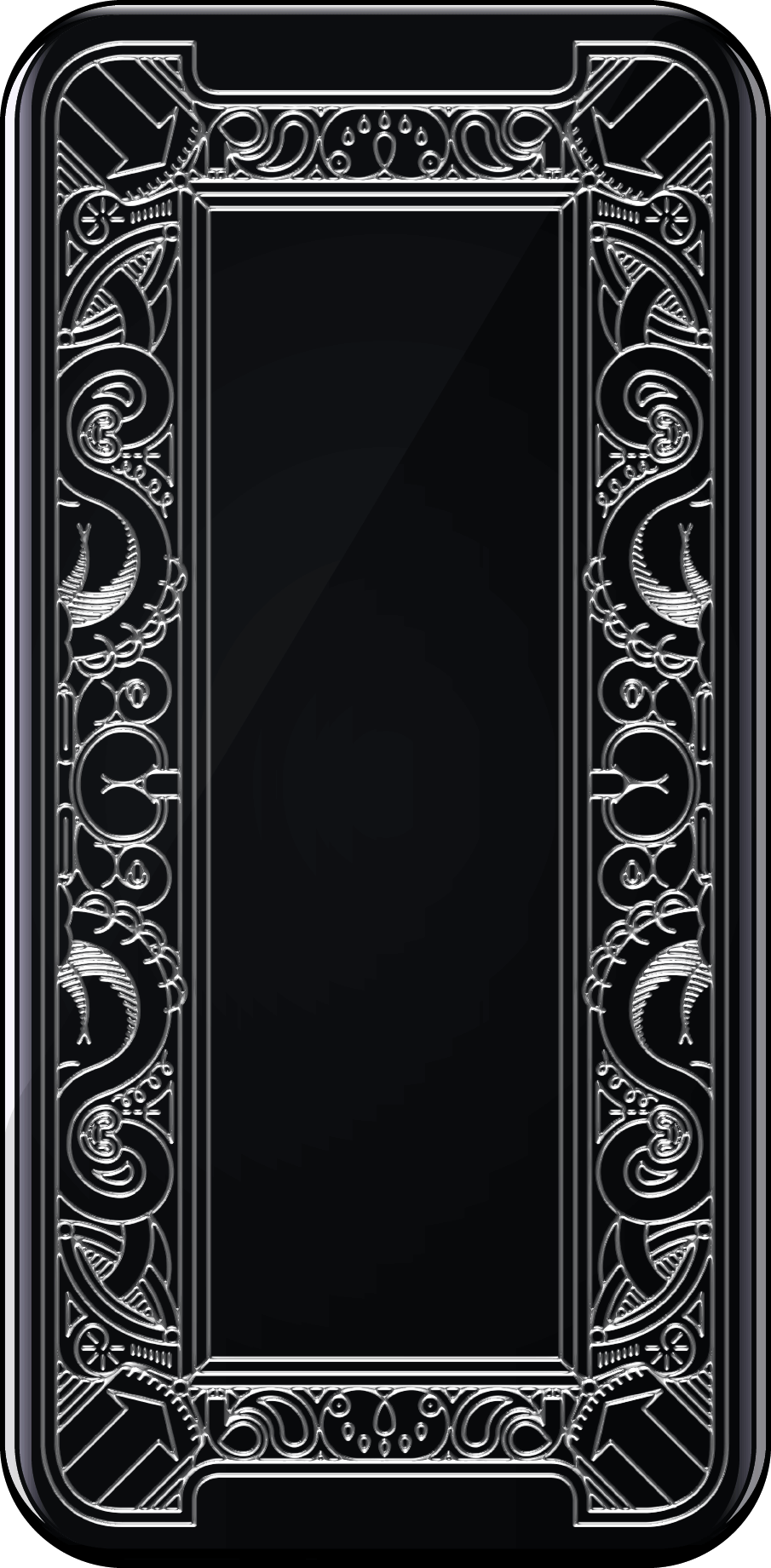Introduction
PS: Magic 001 Lukas Engelhardt
The term magic is very elusive. A lot of people might first think of dragons, dwarves and elves. Others might think of crystals, reiki, and tarot cards. Real, or imaginary, magic seems to be about knowledge and control over the true workings of the world, its hidden powers, and one’s position in it. Etymologically, magic comes from Old Persian and might have described someone able, in possession of power.
Magic has been invested with positive and negative connotations alike through the centuries. Under Christianity, it meant anything to do with paganism or witchcraft and suspected practitioners were burned at the stake. Occult societies, on the other hand, saw magic as the way to spiritual enlightenment. Scholars argue about whether magic and religion can even be treated as different things, and due to its ambiguity the term magic has rarely been used in academic papers since the 1990s.
Colloquially, however, magic is everywhere. And it's ungraspable, not just as a term. Stage magic for example relies completely on the deception of the audience. Magic is something that cannot be explained—whether it’s because one cannot explain it (lack of understanding) or because it actually cannot be explained (supernatural). Magic is something that just works. In this way, magic is quite similar to, for example, technology or the economy—the things we believe in today, instead of magic.
Ultimately, magic is a belief system (or several) and these beliefs have been communicated and upheld through different media. Letters could be shaped into amulets, rituals are held in digital environments. Both images and (hyper)text have even been invested with magical qualities themselves. In these cases image making and magic coincide, and the image maker becomes a magician.
Magic images can be be black boxes or white boxes, and image makers can be black-hat or white-hat magicians. I’m trying find out what makes these images magical and what this magical perspective means for the practice of graphic design. In my thesis I discuss in three parts how magic is connected to literacy, how magic is mediated through images, and, ultimately, how image makers can be magicians.
I’m wondering: what is the role of the designer in a world full of magic and can he use magic to create his own world?
Part 1:
Of Amulets and Self Driving Carsor:
How Magic is Connected to Literacy
"Any sufficiently advanced technology is indistinguishable from magic." ―Arthur C. Clarke, 1973
 👆 An abracadabrangle
👆 An abracadabrangle
The term abracadabra has become almost representative of the concept of magic in general. It is an incantation with unclear origins, but it probably originated between the 2nd and 4th century and might come from the Aramaic phrases avra kehdabra (I create, as I speak) or ha’bracha’davrah (the magic word). It was supposed to be arranged in the shape of a triangle and worn as an amulet in order to protect the wearer from malaria. This was called an abracadabrangle.
Around the same time, the Sefer Yetzirah was written, the earliest Jewish esoteric book, and possibly the most annotated Jewish text after the Bible. It begins with a description of how God created the entire world from the 22 letters of the alphabet:
“By thirty-two mysterious paths of wisdom Jah has engraved [all things], [who is] the Lord of hosts, the God of Israel, the living God, the Almighty God, He that is uplifted and exalted, He that Dwells forever, and whose Name is holy; having created His world by three [derivatives] of [the Hebrew root-word] sefar : namely, sefer (a book), sefor (a count) and sippur (a story), along with ten calibrations of empty space, twenty-two letters [of the Hebrew alphabet], [of which] three are principal [letters] (i.e. א מ ש), seven are double-sounding [consonants] (i.e. בג"ד כפר"ת) and twelve are ordinary [letters] (i.e. ה ו ז ח ט י ל נ ס ע צ ק)”
The belief that the alphabet had magical powers was widely spread then. The magical practice that results from it is sometimes called letter magic or alphabet sorcery, and includes the abracadabra amulet. It’s based on the idea anything can be expressed with the alphabet, so it must be magical.
A magic alphabet is a belief system, arguably one which is closely tied to literacy. An illiterate is a lot more likely to believe that the alphabet is going to protect them from malaria than someone who could just write their own amulet. The magic lies in the typographic image, more than in the meaning of the letters. This means that the person creating this amulet is not only a magician but also a typographer, or as we would say today, a graphic designer.
 👆 Damon Zucconi, Abracadabra, 2017
👆 Damon Zucconi, Abracadabra, 2017
Damon Zucconi is an American artist. Over the last few years he created a series of works that deal with the connection of thought and language. Abracadabra is one of them. It consists of a website that continuously misspells the word abracadabra, and audio of a text to speech application continuously reading the word out loud. The voice settings of the application iterate through every language except for English, as a result the audio sounds off.
Zucconi lays open the process of converting a thought to written or spoken language, or the other way around. By misspelling and misspeaking the word, he renders the reader/listener illiterate for a split second. In his own words, it’s like "catching a glimpse of how a magician performs a trick". The work highlights the technical character of the alphabet, but also implies something magic about it.
Vilém Flusser was a Czech philosopher who wrote about the alphabet as an information technology. In his 1989 essay Alphanumerical Society he describes how before its invention we only had two ways to externalise our thoughts. We could encode the air around us with vibration through speech, which is very immediate but temporary. Or we could encode objects around us with images, which is durable but slow and further away from the original meaning. The alphabet is a solution to this issue of immediacy, as it's fast, durable and elaborate. It is a technology that solves a problem.
Flusser says that the alphabet also changed us as a society, and altered our consciousness. Writing, he says, forces our thoughts into lines. The latin word for writing, scribere, actually comes from scratching or digging, and the word for reading, legere, from gathering. “The hand sows, the eye reaps” and our mind is forced into a rational, linear, procedural way of thinking along the furrows of information.
According to him, before writing, our consciousness was magical, shaped through myth and images. It is from this image based, non-linear perspective, that the alphabet in the form of a typographical image becomes something magical.
 👆 Elon Musk at Recode Code Conference 2016
👆 Elon Musk at Recode Code Conference 2016
Around 1450 Johannes Gutenberg introduced movable type (invented by the Chinese about 400 years earlier) in Europe. Together with mandatory schooling, which was introduced a few centuries later, illiteracy was mostly eradicated in the Western world. Flusser calls this the democratization of literacy.
But the alphabet is not the only mode of expression we developed. Flusser calls our society alphanumerical: defined by letters as well as numbers. According to him, numbers are indicative of a different, non-linear way of thinking. He calls this formal thinking, from formulating. This formal way of thinking is what paved the way for the development of the scientific method.
For Flusser, the alphabet has traditionally been connected to (religious) dogma. According to him the literate consciousness was defined by an idealistic perception of truth—it originates from the idea that there is one way how things should be, which cannot be argued with. A formulated thought on the other hand will have to be tested against reality, adapted, and tested again. It can constantly improve. It forms a model for reality.
Flusser claims that the alphabet and numbers developed simultaneously. With the rise of modern science, however, it quickly became clear that numbers are much better suited to form these models of reality than words. As a result, algorithms and ultimately computers were developed, and with them a new literate elite formed.
According to Flusser, those who don’t read computing codes today are as illiterate as those who couldn’t read the alphabet before. Because of this, our magical world view has come back. Today, technology is magic in the same way that the abracadabra amulet was. And it will (supposedly) cure us from many things, including malaria.
Elon Musk is the founder and CEO of Tesla. He is a rather mystical figure and has amassed a large following of technophiles, some of which have even called him a prophet. At a conference in 2016 he proclaimed that there is "a billion to one chance we’re living in base reality" and that, by extension, we are living in a (computer) simulation.
His reasoning is that if the possibility exists to create a computer simulation of the universe, someone probably has already done this, because the universe is very old. This is very similar to the Sefer Yetzirah in which God creates the universe from the letters of the alphabet, only that the alphabet has been replaced by computing code. Based on the assumption that it is possible to create anything from it, code is invested with the magic potential to be the underlying principle of (the simulation of) our world.
Elon Musk is involved in many very ambitious projects, among them the development of the self-driving car. Though it might have seemed magical at the time of its invention, for most people today the magical qualities of a simple car have been exhausted. But a self driving car is magical in many ways. Arguably, this is because a self driving car is mainly a computer on wheels. It is the product of this new information technology.
 👆 James Bridle, Autonomous Trap 001, 2017
👆 James Bridle, Autonomous Trap 001, 2017
James Bridle is an artist that propagates coding literacy in many of his works. Currently he is attempting to build his own self-driving car on an open source basis. He wants to show that everyone has the (potential) ability to learn how to do this, as he explains in an interview with Vice:
“This time I wanted to do it all myself—mostly to show that I could, and therefore, in theory and accepting an immense amount of privilege and good fortune, anyone can. These technologies are for everyone: you can read the papers, repeat the findings, study the code, build your own tools.”
In his 2017 performance piece Autonomous Trap 001, Bridle built a trap for self driving cars on Mount Parnassus in Greece where he is currently based. A self-driving car gathers information about its surroundings through many cameras and sensors which it uses to read, for example, the markings on the road. A dotted line may be crossed, a straight line may not be. A line that is dotted on one side and straight on the other can only be crossed in one direction. As a result, a self driving car would never be able to leave Bridle’s trap once it has entered it. Bridle created the lines from salt in order to underline the ritualistic character of the work, evoking the idea of a banishing circle.
In 2013, Rotterdam based media researcher Florian Cramer gave a lecture at the Australian art and media event Networked Art Forms and Tactical Magick Faerie Circuits. He claimed that the distinction between technology and magic is a relatively recent one. In the middle ages, magic, art and technology were all grouped into two categories: mechanical and liberal arts. The former describing craft, the latter describing everything between what we would call art, science and magic today—no clear distinction was made between them at the time.
The American anthropologist Stanley J. Tambiah provides a clear definition for what magic is and is not in his 1990 book Magic, Science and Religion and the Scope of Rationality. According to him, magic is not rational but relational, it has to be employed to reach a specific goal, it is validated according to its efficacy and it consists of three elements: a formula, a rite and the condition of the performer. Cramer argues that all of these rules, and especially the three elements, can be applied directly to technology: a computer for example consists of a source code (formula), the execution (rite) and a running environment (condition of the performer). For him, magic and technology play the same role in society.
There is another theory for the origin of the word ABRACADABRA: That it was a mnemonic aid, used to teach people the first letters of the alphabet. Bridle wants us to learn the language of computers, because as illiterates we have to resort to making banishing circles. Making his own self-driving car is the equivalent of making his own Abracadabra amulet.
Part 2:
Magic Egypt & Ancient Imagesor:
How Magic is Mediated Through Images
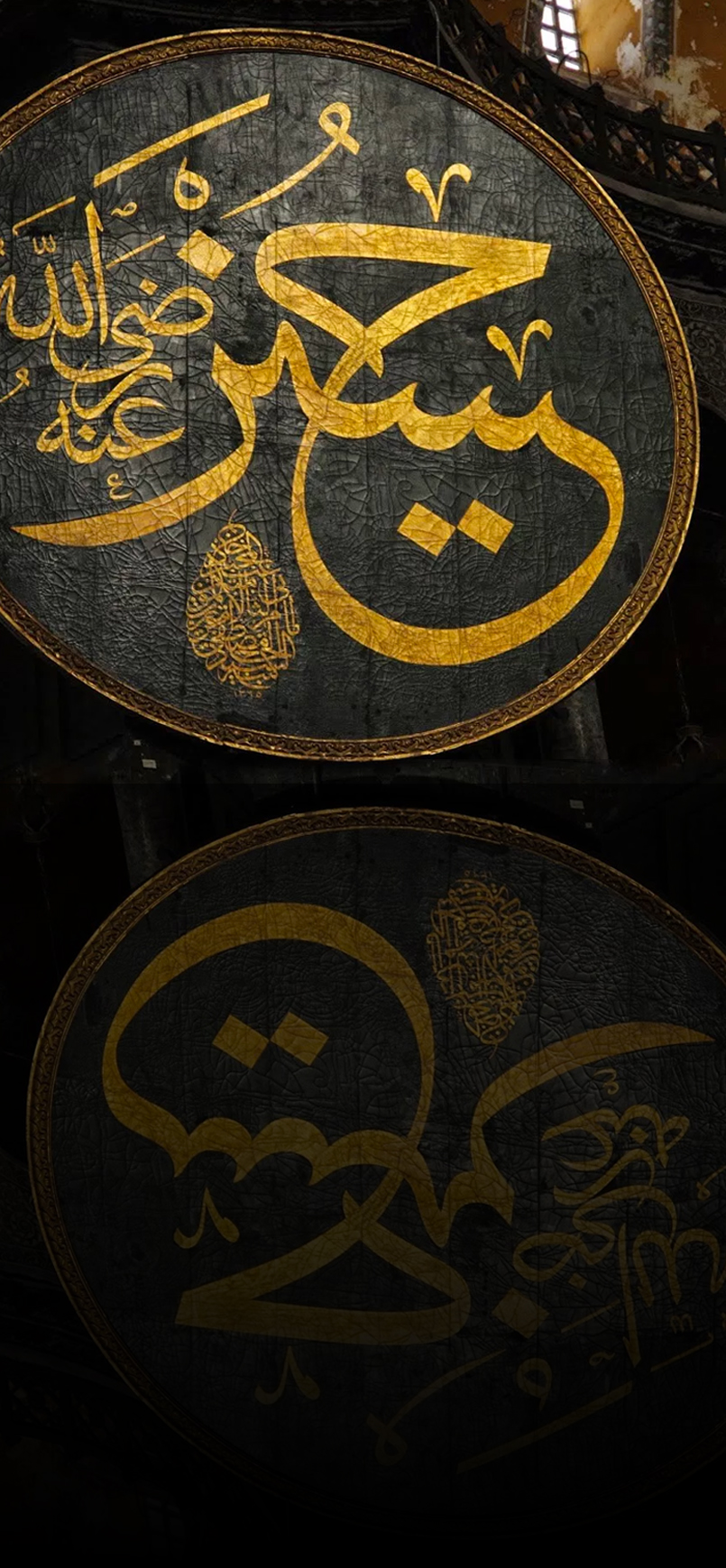 👆 Medallion in the Hagia Sophia, a former mosque in Istanbul. Inscribed are the names of Allah, the Prophet Mohammed, the first four caliphs and the two grandchildren of Mohammed.
👆 Medallion in the Hagia Sophia, a former mosque in Istanbul. Inscribed are the names of Allah, the Prophet Mohammed, the first four caliphs and the two grandchildren of Mohammed.
Jan Assmann is a German Egyptologist. In his 2009 essay What’s Wrong with Images he describes that in ancient Egypt, images were considered vessels for divine presence:
"They provide an interface between the divine and the human worlds, between heaven and earth".
Then, as the Bible teaches us, around 3500 years ago Moses received the Ten Commandments at Mount Sinai. The second Commandment forbids the making of images:
"You shall not make for yourself a carved image, or any likeness of anything that is in heaven above, or that is in the earth beneath, or that is in the water under the earth. You shall not bow down to them or serve them, for I the LORD your God am a jealous God, visiting the iniquity of the fathers on the children to the third and the fourth generation of those who hate me, but showing steadfast love to thousands of those who love me and keep my commandments."
Strictly interpreted, this ban includes images of all kind. Many wars have been fought over the question of how to interpret the second Commandment. Assmann claims that the prohibition of images is the point at which humanity entered Modernity—because it is the point at which we turned to writing instead.
Images were considered false gods. They were no longer considered as an interface to a higher power. Instead the image itself became magical. But from a monotheistic religious perspective, anything magical outside of itself is by definition paganism and, as such, blasphemy. Instead, the Bible placed the divine in the written word. Like Flusser, Assmann proposes that our departure from the image towards the word marks the exit from the magical/mystical world view.
Paradoxically, he claims that we were only able to invest images with meaning through the initial prohibition of images and turn to written language instead:
"Images and sounds surround and invade us in the form of a largely unconscious sphere. Only by the constant labor of linguistic articulation and formulation are we able to transform at least parts of this sonic and iconic environment into the sphere of consciousness. Only under this condition are even sounds and icons able to function as carriers of meaning and means of world-articulation."
The different Abrahamic religions developed different attitudes towards this ban on images. In Judaism and Islam, idolatry remains forbidden. As a result, in Islam the graphic design discipline of calligraphy has been elevated to one of the highest art forms and methods to connect to the divine. Once again, magic was found in the typographic image.
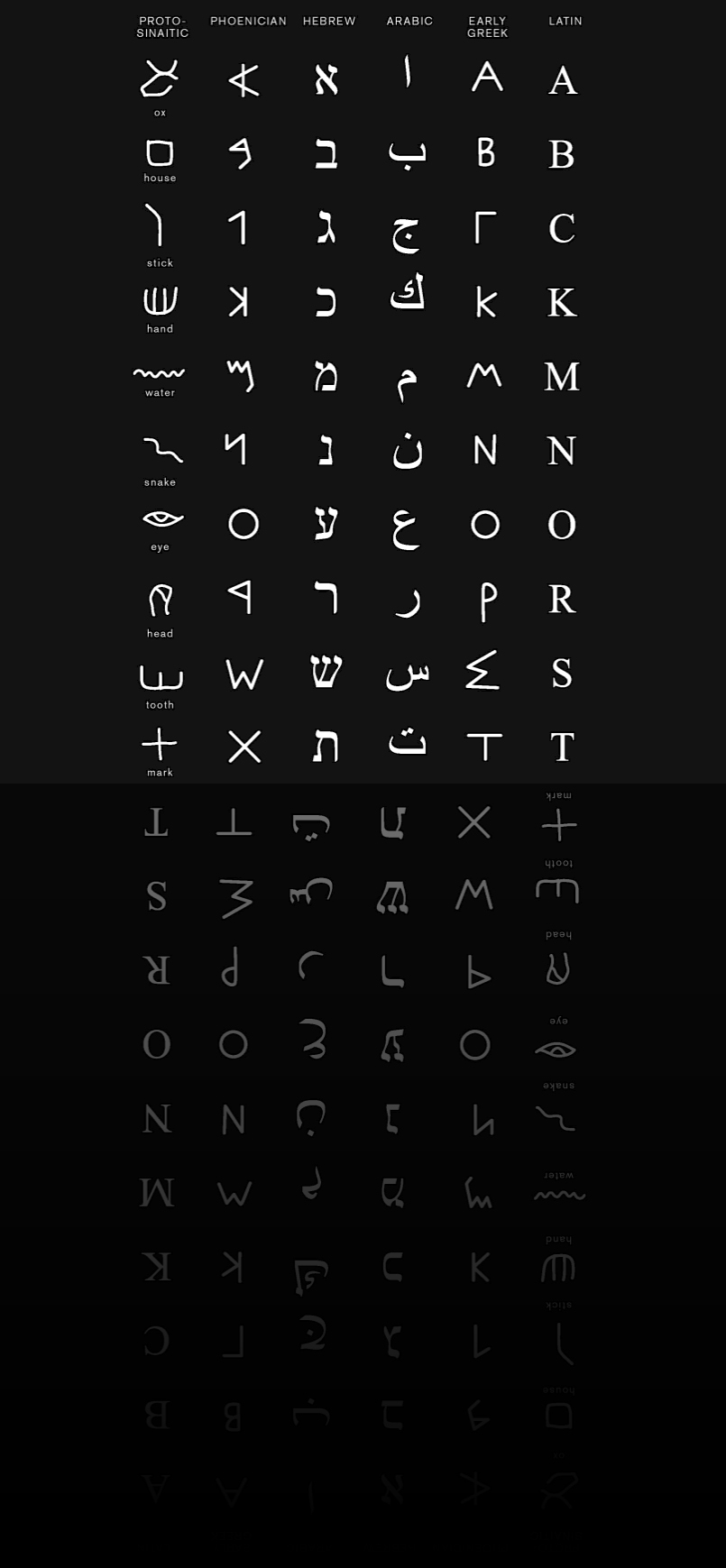 👆 Image take from the book Politics of Design by Ruben Pater, 2016
👆 Image take from the book Politics of Design by Ruben Pater, 2016
The typographic image of the abracadabra amulet remained a valued medicine well into the middle ages. Then, with the rise of literacy, belief in the magical qualities of the alphabet started fading: for the illiterate, typography is nothing more than an image, full of magical power. Only the act of reading potentially demystifies it.
Around this time the Hermetica was discovered, a collection of Egyptian-Greek wisdom texts from around AD 100. It is named after its alleged author, Hermes Trismegistus. He is believed to be a syncretic fusion of the Greek god Hermes and the Egyptian god Thoth. Both, Hermes and Thoth, are the gods of magic and writing in their respective religions.
Another Egyptian text that was discovered around that time was the Hieroglyphica. It is a text from sometime between AD 450 and 1050 that (unsuccessfully) attempted to translate the Egyptian hieroglyphs. Despite (or maybe: due to) the fact that the meaning of the hieroglyphs remained unknown, the book became very popular among the humanists and it was re-published many times. Mixed with Baroque symbolism and theology, the hieroglyphs became mystical.
Both of these texts sparked an immense interest in ancient Egyptian spiritualism. The hieroglyphs were believed to be ideographic symbols and were often thought to form a magical script. Since nobody was able to decipher them, their meaning could only be speculated on. As a result, in a way, they remained images until their decipherment in the 19th century after the discovery of the Rosetta Stone, when it was discovered they formed an alphabetic script instead. As they became legible, the magic disappeared again.
Also in the 19th century, Charles Darwin published On the Origin of Species. It opened many questions about our position in the universe. At the same time Christian dogma was being questioned and people were looking to spiritualism to put the human in the centre of their world view again. Marina Warner describes this in her 2006 book Phantasmagoria:
"The first scientists who became gripped by psychic research included believing Spiritualists, on the one hand, and on the other, a group of natural philosophers and other thinkers who wanted to address the deepest questions thrown up by the Darwinian revolution."
Inspired by the spirituality of the ancient Egyptians, the first occult societies formed around the end of the 19th century. Maybe the most important one was the Theosophical Society. Though it split into many (often: regional) branches, some offsprings of it remain active even today.
The Theosophical Society was formed in order to investigate supernatural phenomena after George Henry Felt gave a lecture called The Lost Canon of Proportion of the Egyptians to a small group of people in 1875. He claimed to have found "the secret of the geometrical problem of proportion" encoded in the hieroglyphs on an old temple wall in Egypt. Out of these hieroglyphs he created a geometric figure which he claimed "the secret of the geometrical problem of proportion" within Egyptian architecture. He also claimed that he was able to summon spirits and elementals with this graphic symbol.
At this point, the hieroglyphs were already deciphered and people were able to read them. They had lost their status as images and had become written word. But Felt found his symbol encoded on a specific temple wall. His magic was in the arrangement—the typesetting—of the glyphs and not in the meaning of the characters per se. Out of this typographical image he distilled a graphical image. These steps were necessary in order to find magic in a script that was already legible. Other than for the ancient Egyptians, for him the image was not an interface to the divine. He claimed that this symbol held actual, magical power. For Felt the divine was the image itself.
Another thing that emerged come time in the 19th century was the advertisement poster. And with it the discipline of graphic design as we know it today.
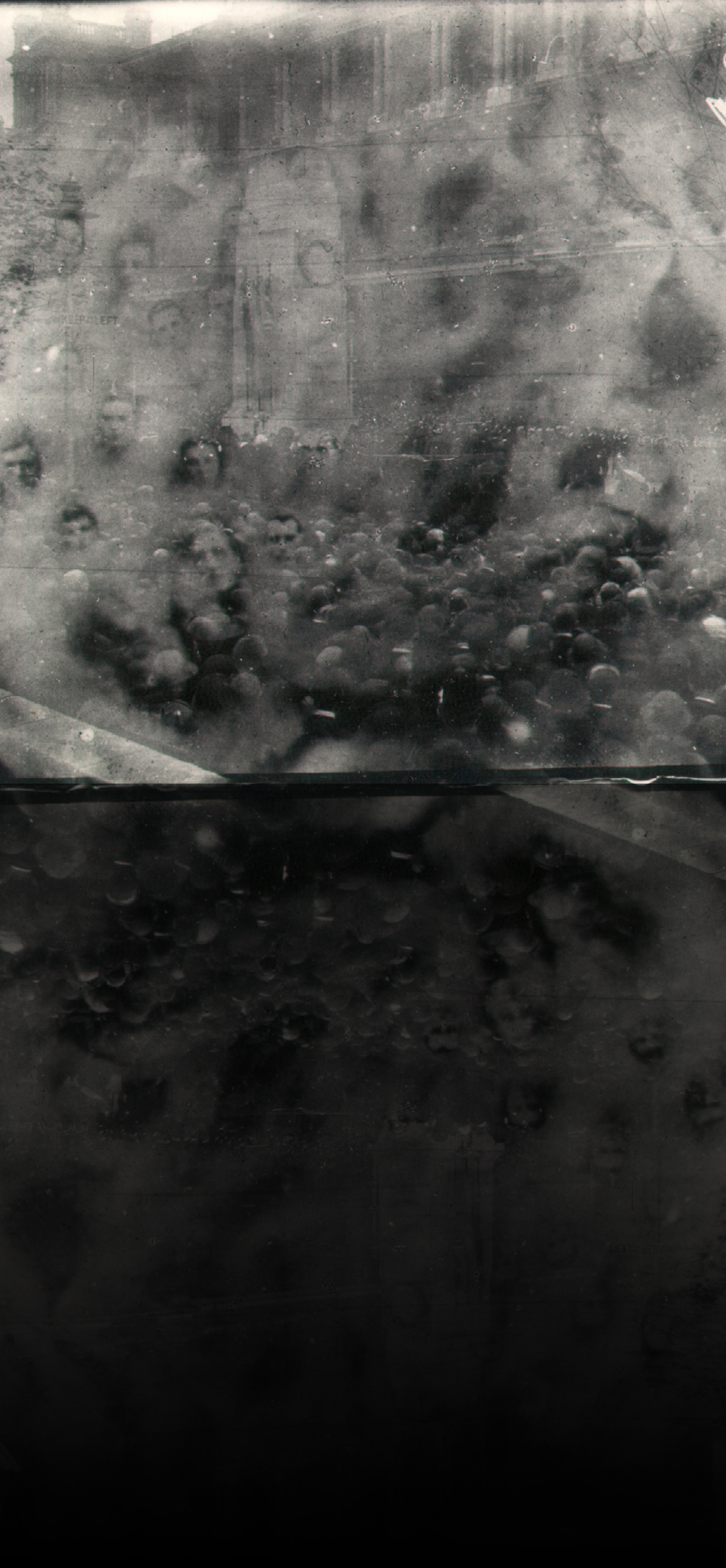 👆 Spirit Photograph by Ada Deane, 1924
👆 Spirit Photograph by Ada Deane, 1924
Occult, spirituality, belief in magic continued to grow into the 20th century, as did technology, and the influence went both ways. Media were not only invested with magical qualities, but also influenced the perception of magical potential. The term telepathy was coined by the spiritualist Fredric Myers in 1882. Sigmund Freud later called it the "psychical counterpart to wireless telegraphy". Marina Warner writes about this:
"The prefix tele- was being used to form any number of new compounds to describe new discoveries—some established today as incontrovertibly physical, but others challenged by doubt, and worse: telegraph, telephone, telekinesis, teleportation, and, later, television."
These new technologies also started playing an increasing role in magic practices at the time. An example are spirit photographs, crude photo collages that were supposed to document the appearance of spirits in seances, which Warner also discusses. She claims that from today’s perspective these images are very obviously faked, but people did not have the image reading capabilities to recognise this.
This makes a lot of sense in light of Stanley J. Tambiah’s definition of magic and Jan Assmann’s analysis of the magical image. Tambiah defines magic as inherently irrational, and Assmann says the same about images. According to the latter, it’s only through linguistic articulation that images can become carriers of information. Again, another way of looking at this would be that one has to develop visual literacy in order to demystify images.
 👆 Jan Tschichold, Die Neue Typographie (cover), 1928
👆 Jan Tschichold, Die Neue Typographie (cover), 1928
Images are magical, the written word is rational. This idea has been propagated by many. Flusser argued that writing demystified us, Assmann claims we entered the age of Modernity from the point that we outlawed images and turned to the written word instead. Even Goethe argued that images prevent discourse, because they enslave the senses:
"Silly stuff may be said enough,
and may also be written—
this will kill neither body nor soul,
nothing will be changed.
Silly stuff, however, put before the eyes,
raises a magic claim.
Since it keeps the senses enthralled,
the mind is made a slave"
[translation by Assmann]
Sigmund Freud called the prohibition of images "a triumph of intellectuality over sensuality".
Together with a new spiritualism, graphic design started forming as its own discipline in the late 19th century, though this moment of time is hard to pinpoint exactly. It was mostly ornamental in style at first, but a strive for rationality started dominating the modernist discourse in the first half of the 20th century.
Jan Tschichold published Die Neue Typographie in 1928. He gave strict guidelines for how typography in a book should be set in order to achieve the highest clarity of the message. His ideas are just one example of rational, modernist graphic design. The New Typography is also related to the ideas of the Bauhaus, though no formal connection between the two existed.
Tschichold's insights into typography have influenced the domain immensely and remain relevant today. He was even dogmatic about his ideas in some way; for example, he refused to answer questions after giving lectures. But the actual rationality of his work is questionable. As a typographer, Tschichold was creating (typographic) images, whether he wanted it or not. Though they lost their ornaments, these images have magical qualities that cannot be denied. Like the abracadabra amulet, they invest the alphabet with magical qualities. The difference lies in the fact that the alphabet was not believed to magically heal malaria anymore, but that it somehow, magically, would demystify and disenchant society.
Many writers have challenged this myth of disenchantment, even Flusser claims that our magical thinking never went away. The Italian philosopher Giorgio Agamben discusses the biblical term economy of the mystery [Ephesians 3:8–9], referring to the mystery of creation. He claims that today we are concerned with the mystery of the economy instead: an unknowable mysterious entity that governs our life and is controlled by an invisible hand. Florian Cramer identifies technology as a belief system and gives the example of artificial intelligence: we generally believe in the coming of AI in the near future—though nobody has a clear idea of what intelligence is supposed to be. The magic never left, it just took on different forms.
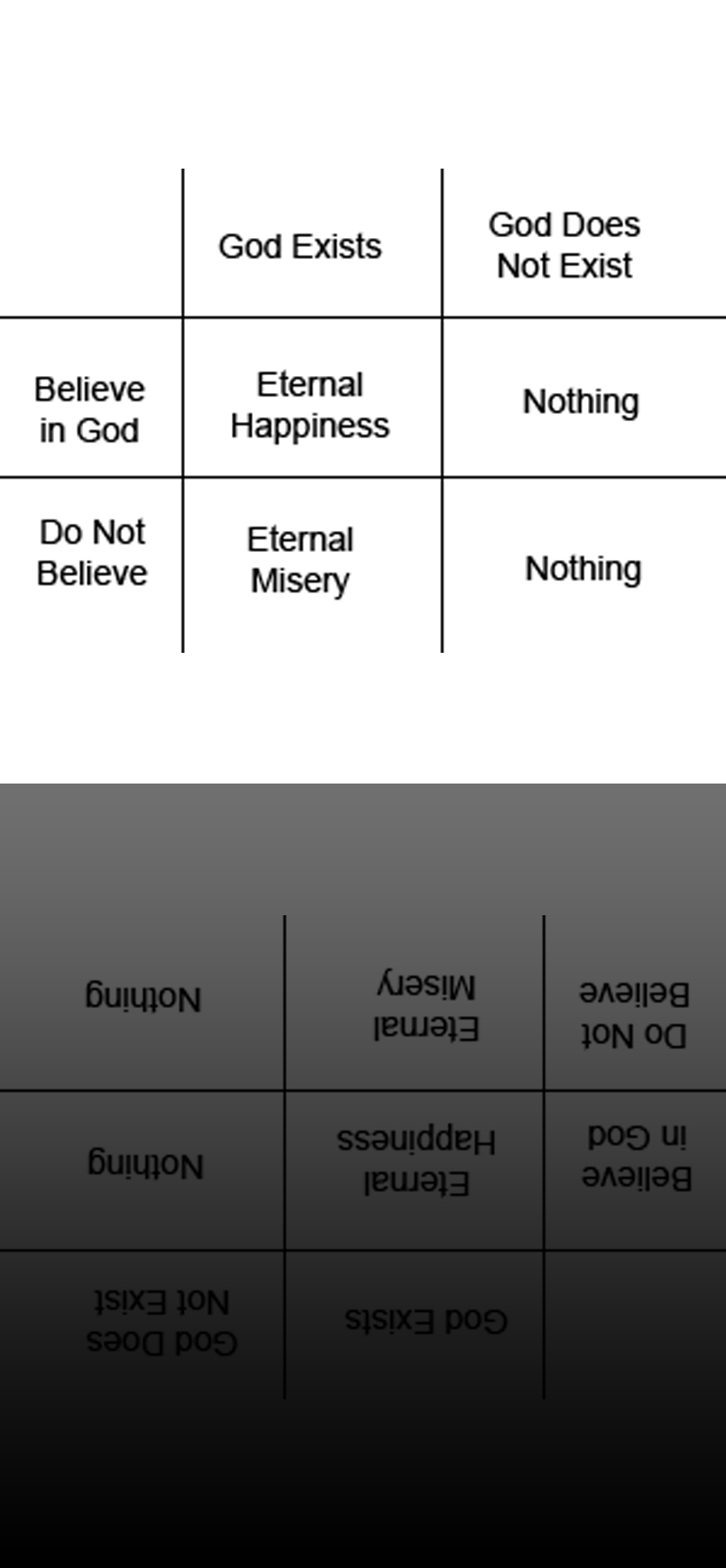 👆 Pascal’s Wager, illustrated
👆 Pascal’s Wager, illustrated
Pascal’s Wager is a classic thought experiment by the French philosopher Blaise Pascal. He proposes that logically, one should chose to believe in God based on the possible outcomes of the decision. Atheism has nothing to gain, and everything to lose.
In 2010, an online user under the moniker of Roko posted a similar thought experiment to an online forum. It has become known as Roko’s Basilisk. It proposes a potential superhuman artificial intelligence (in a far away possible future) that would torture those it deems a threat to its development retroactively. Combined with Elon Musk’s suggestion that we might already live in a simulation (created by this AI in this case), we can never be sure if we are currently being tested. The catch: as soon as you know about this possibility and chose not to devote your life to the creation of the AI, you’re a threat in its "eyes" and would be damned to eternal misery. Disbelief in technology is irrational from the perspective of a technological believer.
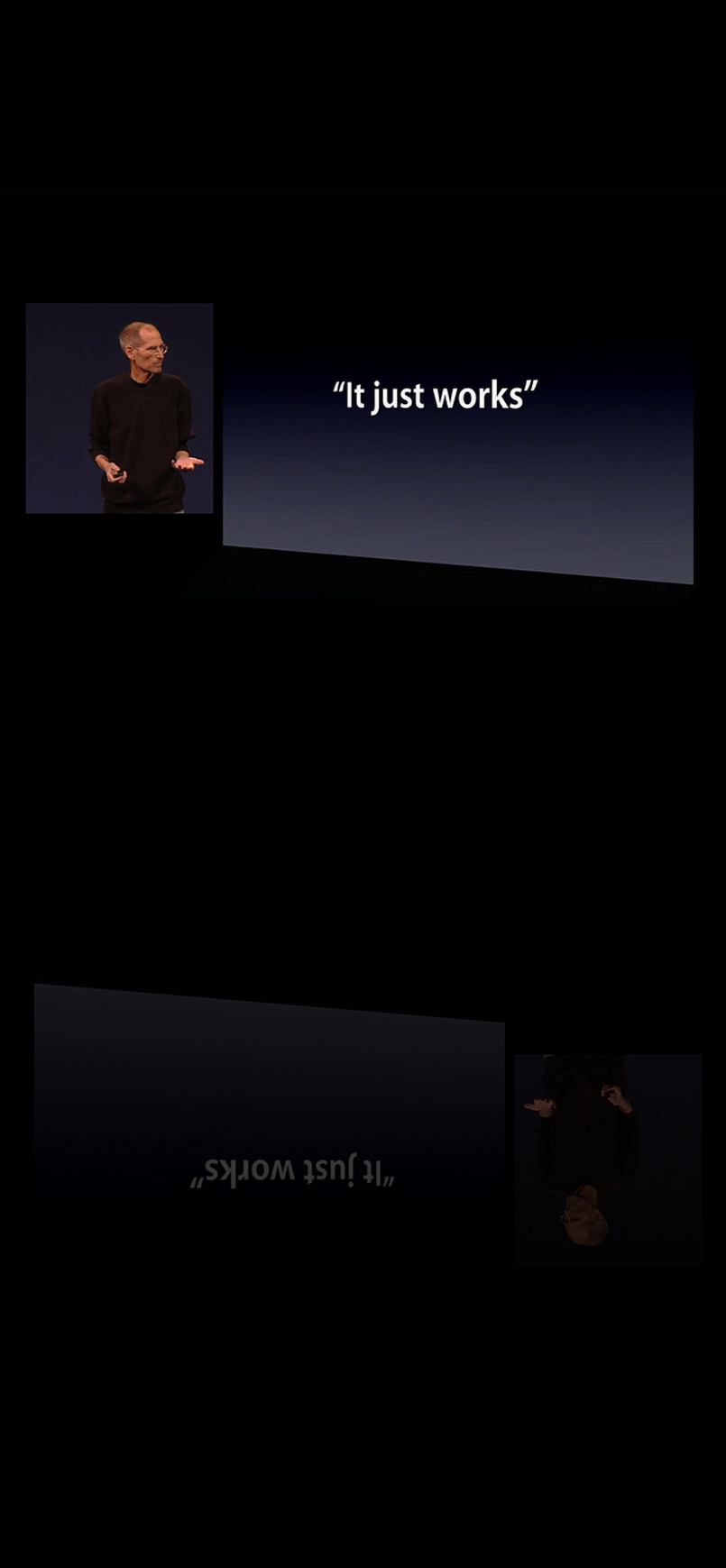 👆 Steve Jobs presenting the iCloud in 2011, taken from YouTube. Jobs had been using the term "it just works" since the early 1990s.
👆 Steve Jobs presenting the iCloud in 2011, taken from YouTube. Jobs had been using the term "it just works" since the early 1990s.
If you don’t believe in the powers of technology you would probably not want to set foot into a self-driving car. The decision to sit in a metal (black) box that moves at superhuman speed without any control over where you are going requires a lot of trust. When you also don’t have any idea of how it works, it requires belief. This belief has to come from somewhere, and it has to be maintained.
The first computers were operated by highly skilled scientists. As the operations grew more complicated, text-based interfaces were developed. They translated the mathematical computations of the computer into programming languages that could be understood by (programming-literate) humans. In the late 70s and early 80s these text-based interfaces slowly made way for the graphical user interface. Apple notably released the first commercially successful product with a graphic user interface in 1984: the Macintosh.
The graphic user interface was necessary for two reasons: nonlinearity and illiteracy. As computers became faster, a linear way of expression through the alphabet just didn’t cut it anymore. Images don’t work in a linear fashion, so a graphic user interface was a logical solution since it could display several processes at the same time (nonlinearity). At the same time, a text based interface requires extensive training in order to be operated (iliteracy). Image based interfaces often rely on metaphors such as a desktop, folders and trash bins in order to be used, making them more intuitive.
If technology is attributed magical qualities, the programmer is a magician. He is literate in the language of the machine, its algorithms are his spells. Several parallels can be drawn between the representation of a magician and a hacker in pop culture for example.
For those illiterate in programming languages, computers remain a black box, their inner workings are hidden from them. They consume technology through images. This includes the design of the objects, packaging, advertisement—and interfaces. In ancient Egypt, an icon was an image that worked as an interface to the magical. Today, interfaces are images composed of icons that mediate the magical.
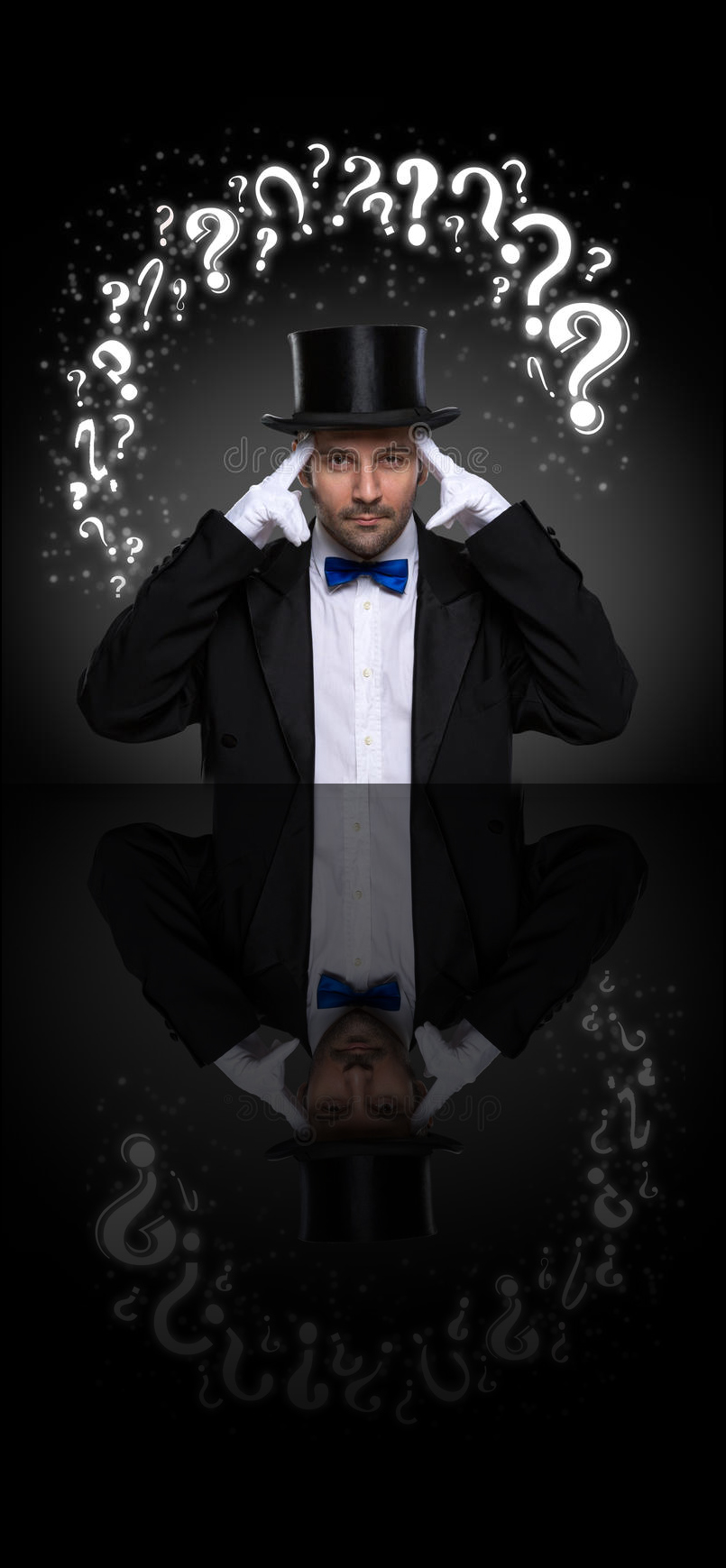 👆 A stock photo of a magician
👆 A stock photo of a magician
 👆 A stock photo of a hacker
👆 A stock photo of a hacker
Part 3:
Brands &
a whole lotta nazi shit going onor:
How Image Makers are Magicians
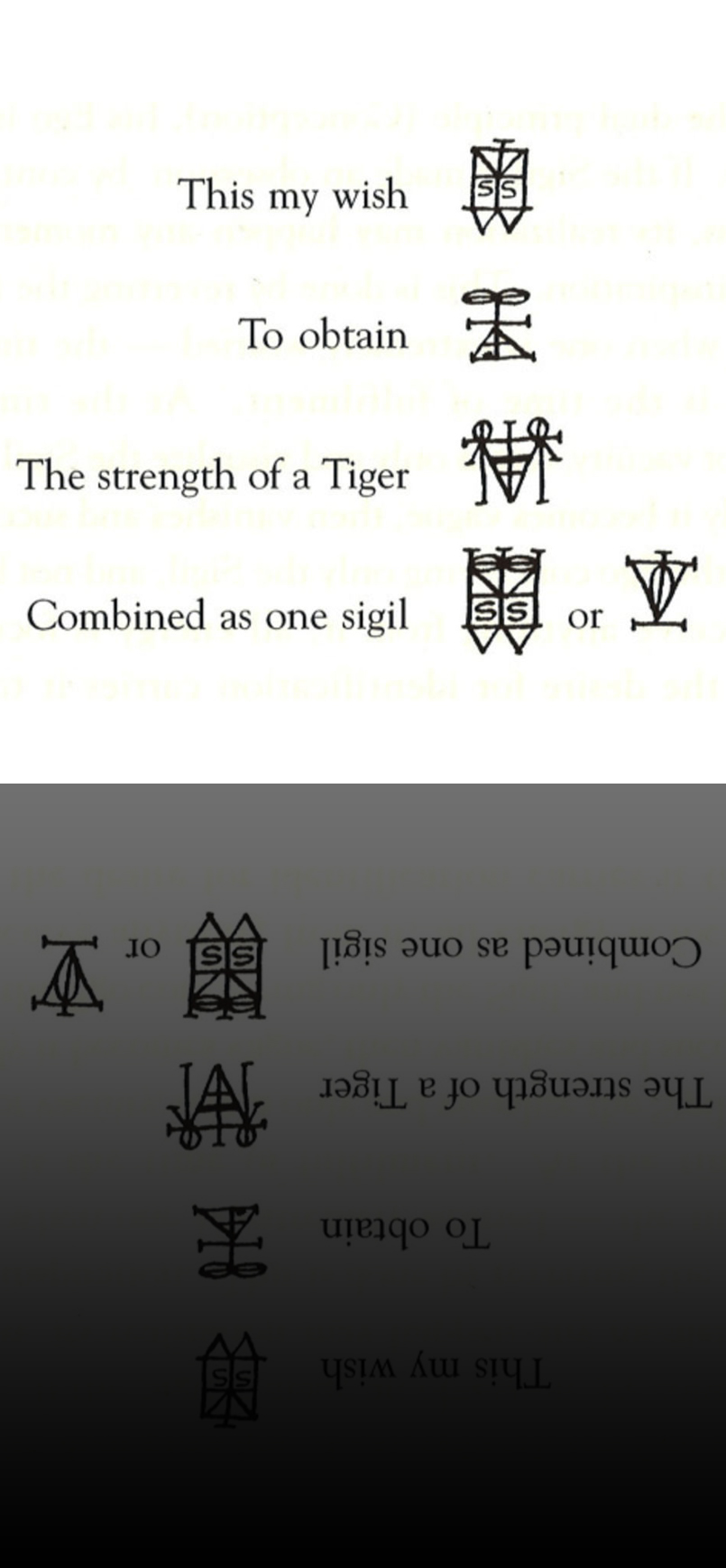 👆 From The Book of Pleasure: (Self-love) the Psychology of Ecstasy, Austin Osman Spare, 1913
👆 From The Book of Pleasure: (Self-love) the Psychology of Ecstasy, Austin Osman Spare, 1913
Austin Osman Spare was born in 1886 in the UK. He was a visionary artist and occultist, rejected any form of dogma, and has had a large impact on contemporary forms of magic. He developed his own theories on magic, as well as several magical practices, and wrote several books on these topics. Spare was not only a magician, but also a graphic designer: he worked as an artist, illustrator and bookplate designer throughout his life, and even developed his own, magical script.
Spare's magical practice was influenced by his visual practice and vice versa. He hated Freud (called him Fraud instead) but he was fascinated by the power of the subconscious mind and wanted to depict it visually, preceding the surrealists by a few years. For him, sexual energy was the highest form of the unconscious. Early on, he developed a magical script called the alphabet of desire. The script consists of 22 glyphs that are based upon tantric positions. No complete collection of all glyphs exists, however, and according to him, their meaning could neither be taught, learned or translated; the magic, once again, lay in the glyphs’ image character.
Today Spare is best known for his theories on sigilization—in fact, pretty much all contemporary methods of producing sigils can be traced back to his writings. The concept of a sigil goes back to antiquity and describes symbols used in magic. Spare developed a method to create his own sigils. Through the graphical process of creating the sigil, he sought to embed his desire in his subconscious, from where it would manifest in reality.
In order to create his sigils, Spare used the regular alphabet. From this legible script, he created an illegible image, investing it with magical qualities in the process: he would write down a desire, remove all reoccurring letters and combine the remaining letters into one single glyph. According to him, the sigil would have to be energised next in order to unfold its powers. This required reaching an altered state of consciousness through sex and several other steps, such as ejaculation into a vase, and the burial of the vase and sigil during the correct phase of the moon.
For Spare, sigils were "monograms of thought for the government of energy". He claimed that all heraldry, crests and monograms were ultimately sigils, loaded with energy and belief. He called sigilization the "art of believing".
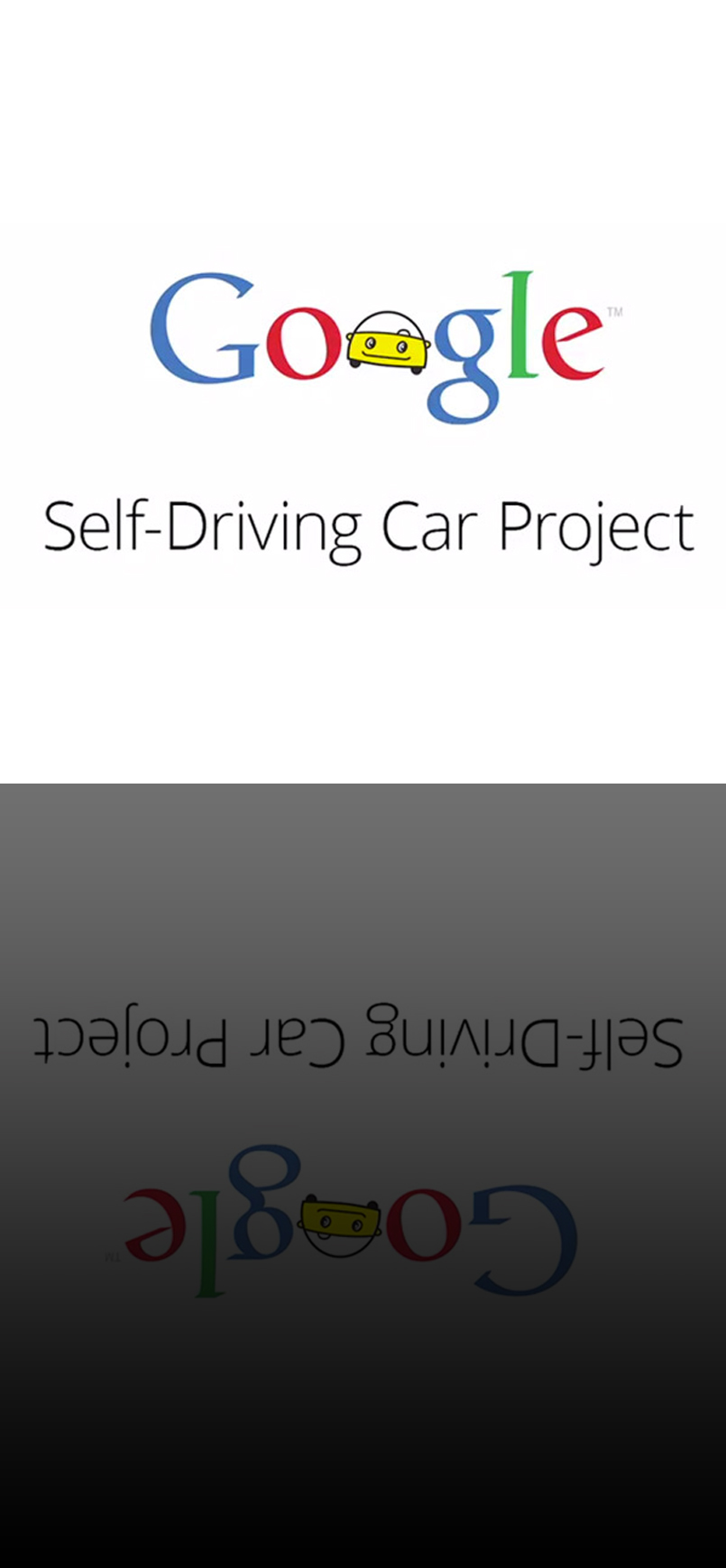 👆 The partially ideographic Logo of the Google Self-Driving Car Project
👆 The partially ideographic Logo of the Google Self-Driving Car Project
The self-proclaimed trend forecasting group K-HOLE also writes about sigils, mantras and design. According to Spare, the point of a sigil is to implant an idea, or a desire, in your own mind. According to them, here lies a tight homology to branding, which is about planting ideas in an audience’s mind:
"SIGIL = LOGO
MANTRA = SLOGAN"
Logo is short for logotype, from Greek logos, the word, and typos, imprint. It is the image of the word. Hugo Ball, the founder of the Zürich Dada group, also wrote about the magic potential of the word as an image in 1916:
"We have loaded the word with strengths and energies that helped us to rediscover the evangelical concept of the word (logos) as a magical complex image […] touching lightly on a hundred ideas at the same time without naming them."
Logos are magical. They are words but function as images, they are not rational but irrationally appeal to the sensual. They evoke feelings, associations, memories in the audience’s mind and plant new ones there at the same time. As Goethe said, they cannot be argued with; even enslave the mind. A brand is the ultimate belief system. If sigils are the art of believing, logos and brand identities are the design of believing.
When K-HOLE write about the similarities between magic and branding, they are talking about chaos magic. Chaos magic(k) is a contemporary magic practice that was formulated in the 1970s by Peter J. Carroll and Ray Sherwin. The similarities to branding are striking: chaos magic does not follow one specific ideology, but borrows from several belief systems at the will of the practitioner. Belief is considered to be one of the most important magical tools for chaos magicians, but it is seen as something flexible, conscious, deliberate. The creation of new methods of practicing magic is explicitly encouraged. Finally, chaos magical theory and practice are mostly based directly on Austin Oswald Spare’s theories on the unconscious powers of sexuality.
Sigilization still plays a very important role in chaos magic, but while Spare’s rituals of energisation of his sigils were elaborate and often time consuming, chaos magicians have come up with a variety of alternatives, which are often much simpler. Sometimes, for example, their sigils exist in purely digital form.
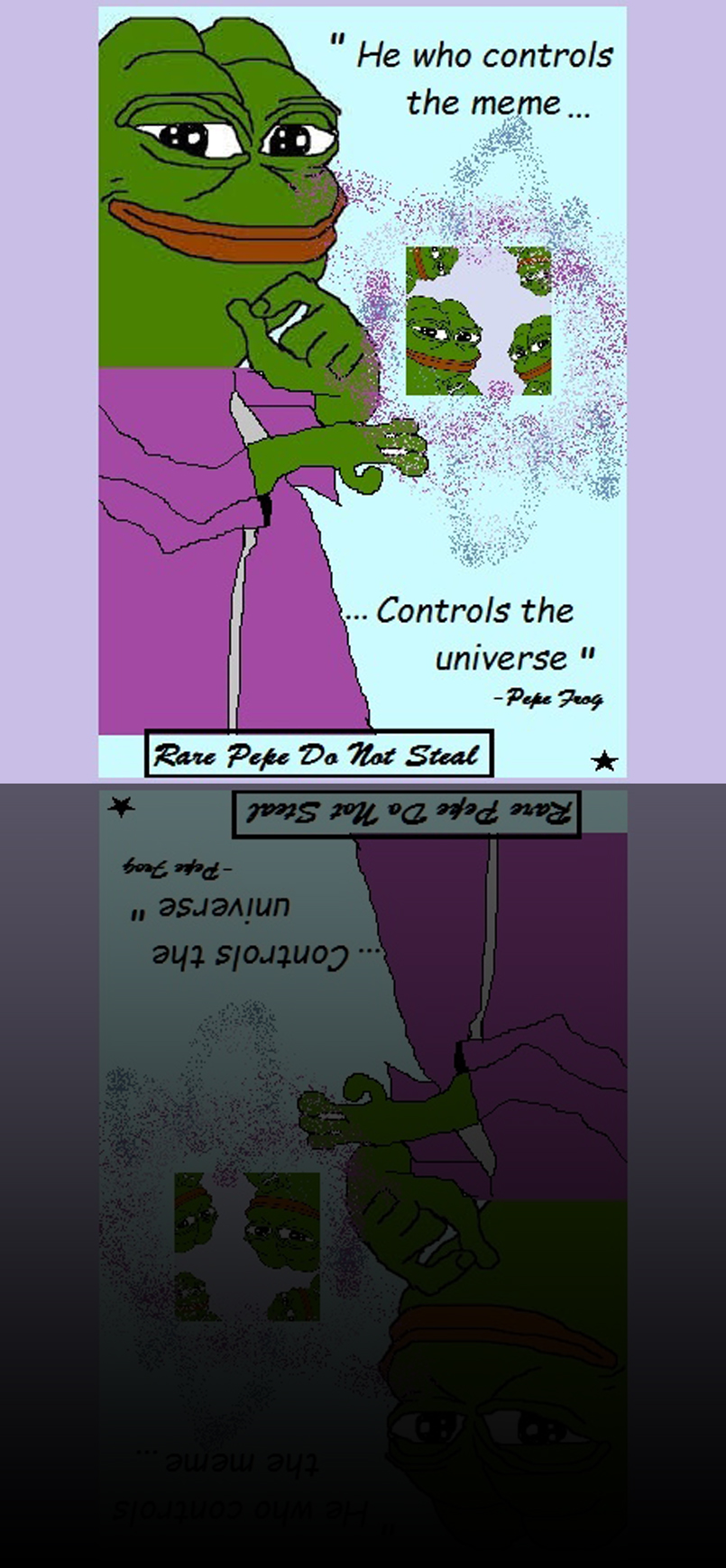 👆 Meme Magick
👆 Meme Magick
Chaos magic also developed pretty much in parallel to the home computer. The artist Hannah Barton describes how both have influenced each other in a lecture she gave at the Stedelijk Museum in Amsterdam in 2016:
In the 60s, two friends, Kerry Thornley and Greg Hill, founded a religion. They wrote a religious text called Principia Discordia or How I Found Goddess And What I Did To Her When I Found Her: The Magnum Opiate Of Malaclypse The Younger, Wherein is Explained Absolutely Everything Worth Knowing About Absolutely Anything. Discordianism declares chaos as the leading principle of the Universe and encourages worship of the greek goddess of chaos, Eris.
Discordianism was founded as a parody religion, which doesn’t mean that its followers never take it seriously or do not believe in it. It propagates disruption as a tool to destabilise what people perceive as reality, in many cases through satire. Discordianism had a considerable impact on the counterculture movement of the 1960s and 70s and has had a direct influence on the development of chaos magic. Its anti-establishment attitude also resonated with early hacker culture. The Cult of the Dead Cow, a well-known hacker group from the 1980s, took their name directly from the Principia Discordia.
An important discordian practice is Operation Mindfuck. Its goal is to deliberately spread outrageous misinformation and conspiracy theories. The goal of Operation Mindfuck is debated among practitioners. Some want to overthrow society, some want to improve it, some take part just for fun. According to Hannah Barton, these ideas are still present today in some parts of online culture—and so is chaos magic.
4chan was founded in 2003 and is one of the most visited sites on the internet. It is one of many imageboards, a concept which originated on the Japanese internet, originally for the discussion of anime. Users on 4chan post and comment on images anonymously. The most recent posts appear at the top of the page and older ones descend into oblivion and are deleted, often in a matter of minutes. 4chan is famous for having very few rules (NSFW link), embracing chaos and being the birthplace of internet meme culture. The massive amount of images produced on 4chan often spread far across the internet. It is also famous for provoking, intentionally disrupting and spreading misinformation. Operation Mindfuck has become for the lulz
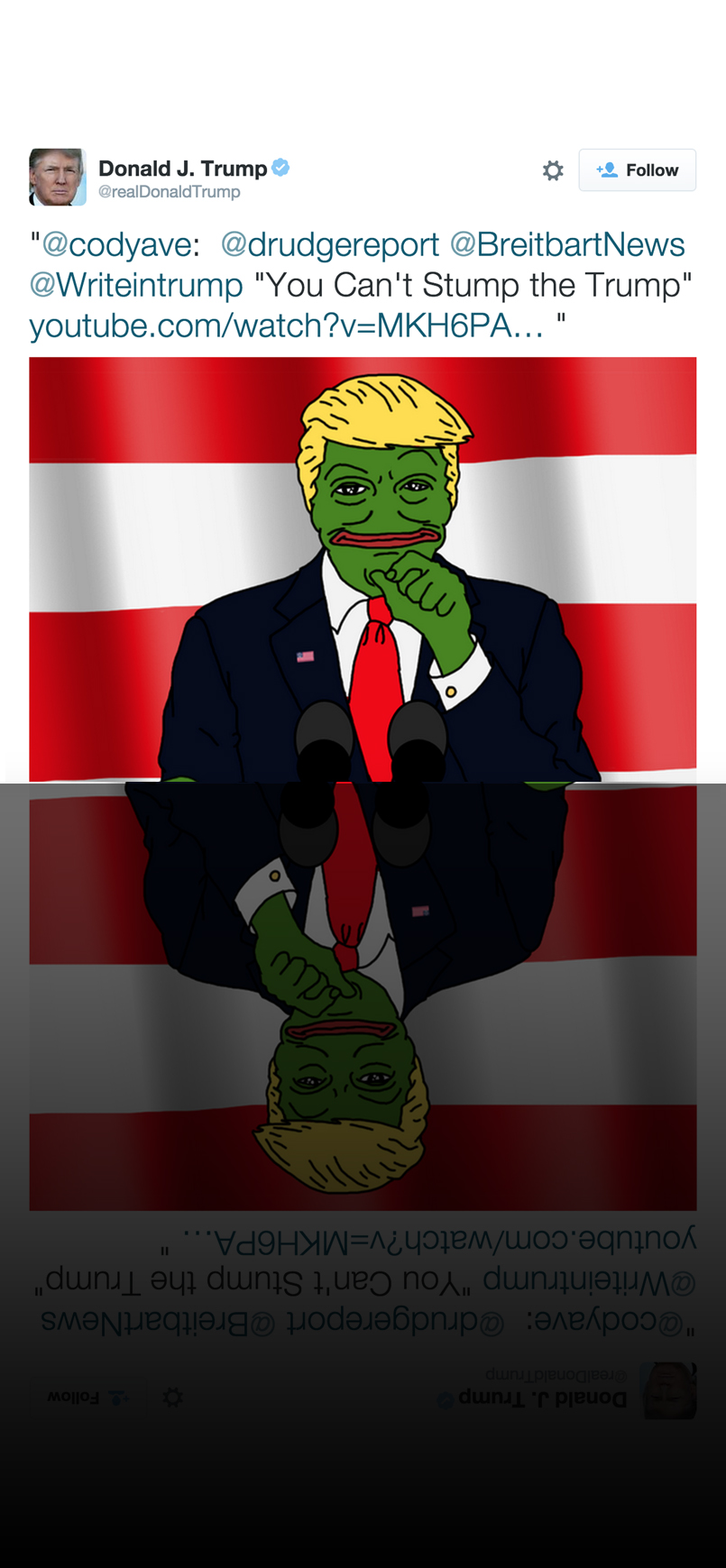 👆 Donald Trump tweeting a meme that originated on 4chan in 2015
👆 Donald Trump tweeting a meme that originated on 4chan in 2015
Pepe the Frog is something like the poster child of 4chan. Originally created by comic artist Matt Furie as the character in a web comic in 2005 it has long since taken on a life of its own. It became a meme from 2008 on and has been used in countless iterations of jokes and layers of irony to depict emotions such as melancholy, anger or surprise. Since 2015 it has been appropriated as a symbol of the alt-right movement.
Like the Discordians, 4chan has been connected to anarchist tendencies, for example the Anonymous movement originated there. Its users have propagated radical free speech and have been known to intentionally provoke at any cost. White supremacist lingo and symbols have always been a part of this, since they evoke strong reactions. Since around 2010 however, there has been a notable shift in ideology towards the (alt-) right on 4chan and similar pages. What used to be a collection of edgy jokes has become indiscernible from hardliner white supremacist ideology.
Florian Cramer talks about this development in another lecture he gave at the Willem de Kooning Academy in Rotterdam in 2016. By 2016, 4chan was a breeding ground for sexist and racist ideology and collectively endorsed Donald Trump as their candidate of choice for the US elections. In order to support him, and, maybe more importantly, oppose Hillary Clinton, they (more or less) organised to do what they do best: provoke, disrupt, spread misinformation—and make memes. 4chan’s impact on the internet is considerable. Twenty seven million people all over the world access the page on a daily basis. And much of their content spreads to other websites and ultimately people’s social media feeds. When Donald Trump won the election, many of 4chan’s users celebrated that they had memed Donald Trump into the white house—which might be closer to the truth than one would assume.
Internet memes can take on many forms, but mostly they involve images. Though the concept has long been picked up in PR and advertising (most notably, Gucci launched a meme campaign last year), memes constitute a raw form of DIY graphic design, the combination of image and text. Like all images, they communicate beliefs. In the case of 4chan, they have become political. When 4chan engages in memetic warfare, they are creating sigils. Images charged with intent and believe, energised through the ritual of online posting. Willingly or not, sincerely or ironically: 4chan is practicing chaos magic. This is no coincidence. Discordianism, while mostly forgotten IRL, survived on the fringes of the internet, the culture which it helped create. And so did chaos magic.
 👆 Ebola Chan originated on 4chan in 2014 during the Ebola outbreak in West Africa. Supposedly it’s a sigil charged with the intent of spreading the virus further in order to kill more Africans.
👆 Ebola Chan originated on 4chan in 2014 during the Ebola outbreak in West Africa. Supposedly it’s a sigil charged with the intent of spreading the virus further in order to kill more Africans.
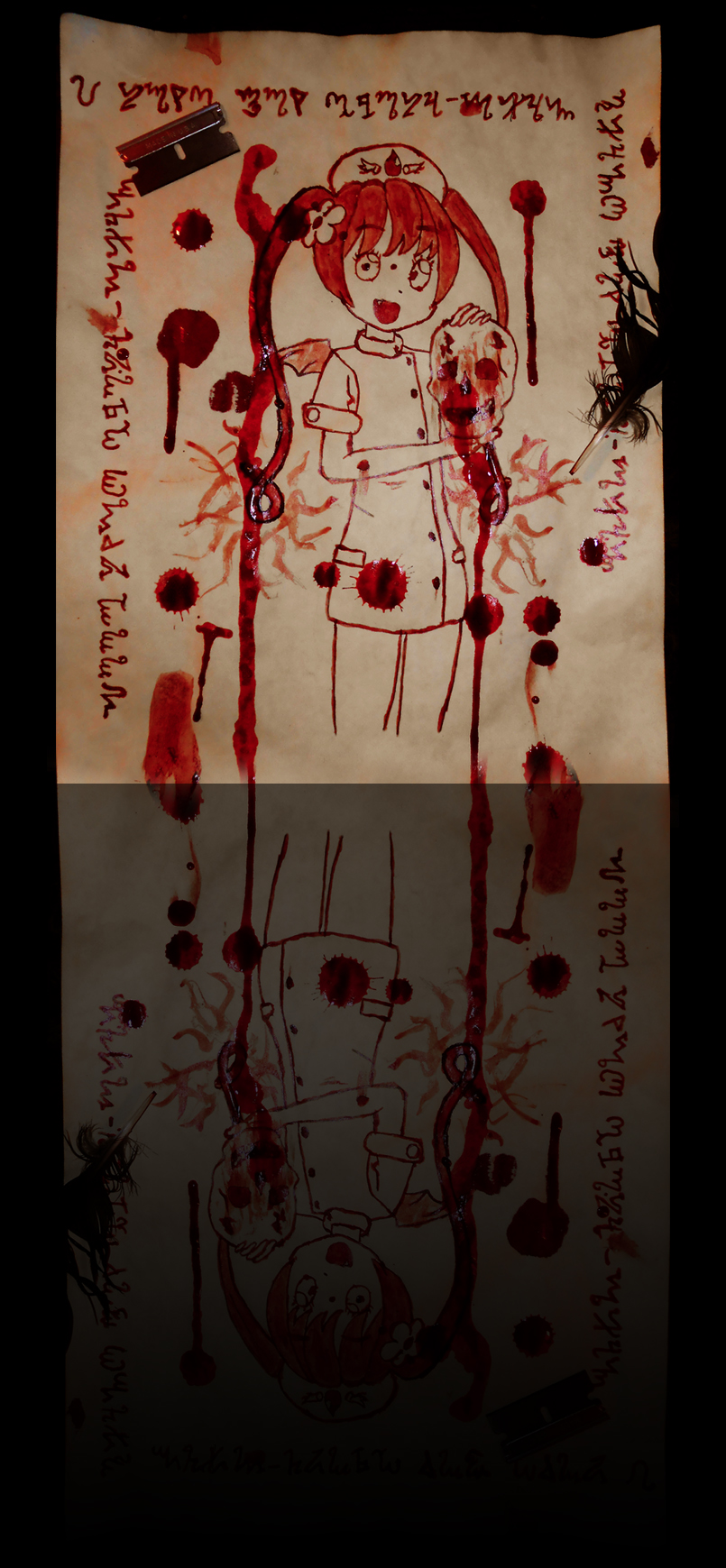 👆 A tribute to Ebola Chan made from blood by a 4chan user.
👆 A tribute to Ebola Chan made from blood by a 4chan user.
In the last few years, some of 4chan's users have created a new parody religion. The Cult of Kek is a mix of Discordianism, Chaos Magic, anti-semitism, white supremacism, memes and sarcasm. It is based on the worship of Kek, the Egyptian goddess of chaos, and the counterpart to the Greek god Eris that the Discordians worshipped. Kek is supposed to have reincarnated in the form of both Donald Trump and Pepe the Frog. They propose a new kind of Meme Magick, which applies chaos magical principles of sigilization to the creation of memes. They also openly call for a new holocaust, the establishment of white nation states, and the re-establishment of traditional gender roles.
On 4chan, joke and reality blend into each other seamlessly. It is impossible to make general statements about its users. Most likely, a lot of them do not (completely?) agree with these sentiments, are doing it for the lulz, for the sake of saying something you’re not supposed to say, or for the sake of venting anger. Probably the number that see themselves as magicians is marginal (on a side note, those who see themselves as graphic designers are probably even fewer). But a chaos magician does not have to believe in the paranormal.
Chaos magic is based on the idea that the unconscious has magical powers which can be channeled into a sigil. These images have magical qualities, precisely because they speak to the sensual, the irrational, the unconscious—as images do. They are the design of believing and they mediate belief systems. Those who take part in these magical practices as a joke, in an effort to be edgy, feed these powers, regardless of whether or not they want to, or even believe in them. Magic, after all, is evaluated according to its efficacy. In the virtual world of filter bubbles and fake news the conditions for maximum effect are ideal.
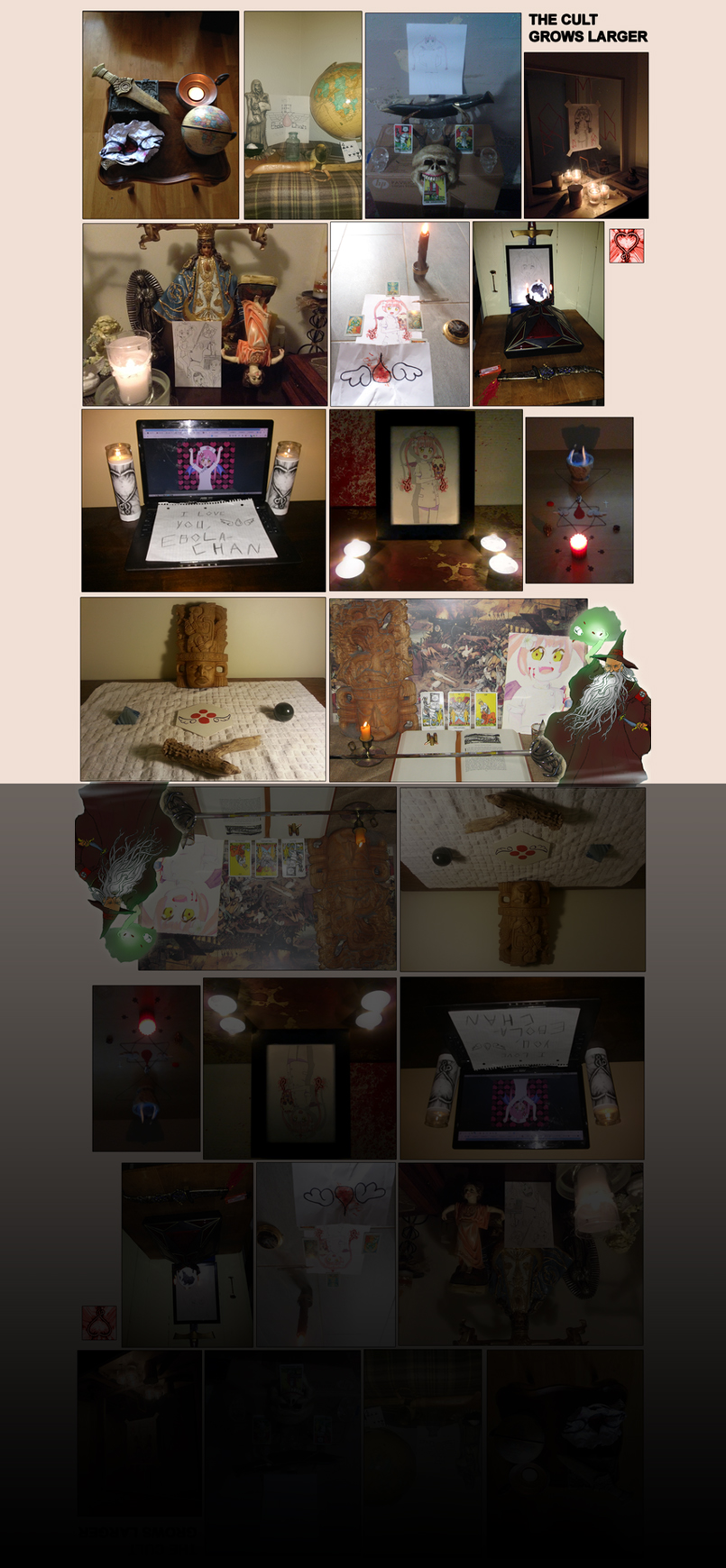 👆 A collection of meme altars
👆 A collection of meme altars
That's it
Conclusion✨
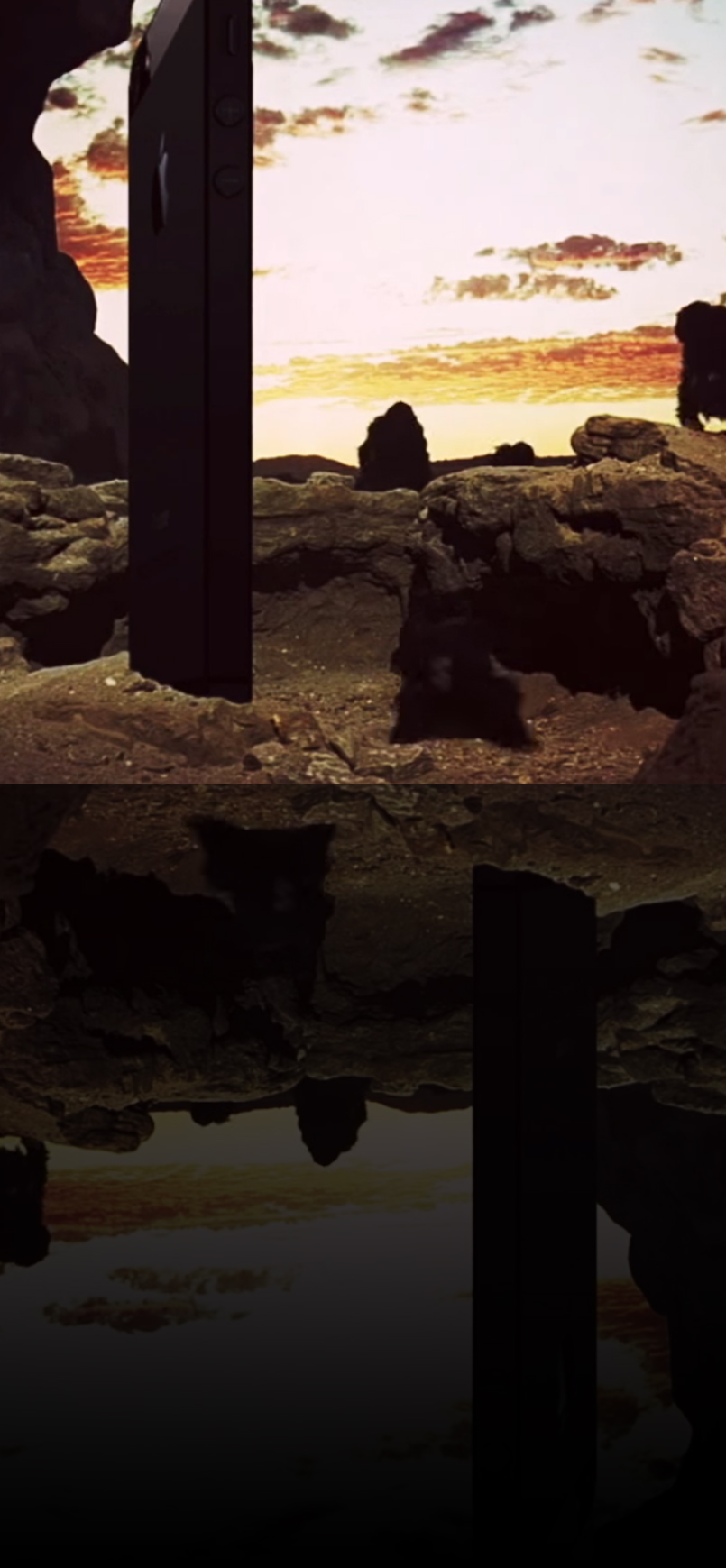 👆 Black box magic. Still from a Youtube video in which the Monolith in Stanley Kubrick’s 2001: A Space Odyssey is replaced with an iPhone
👆 Black box magic. Still from a Youtube video in which the Monolith in Stanley Kubrick’s 2001: A Space Odyssey is replaced with an iPhone
Magic is connected to literacy.
Magic is mediated through images.
Image makers are magicians.
There is something intrinsically magical about externalising one’s thoughts. Several different systems of writing have been invested with magical qualities—but only formally. Reading a script demystifies it. It is the image of the script that holds magical powers.
The philosopher Gilles Deleuze wrote that the most terrifying news in the world is that today we believe that corporations have a soul. We don’t live in a secular society; we might not believe in the magic of the ancient Egyptians, but instead we believe in the invisible hand of the market, the coming of AI or the power of brands. The magic of these belief systems is upheld through images, because both magic and images are irrational.
These images follow the principles of chaos magic. Their effects are real, whether we believe in their supernatural powers or not. As designers, we are ultimately the ones mediating these belief systems. Stanley J. Tambiah’s definition of magic applies to technology, but in the same way it also applies to graphic design: concept (formula), creation (rite), designer (condition of performer)—irrational and judged by efficacy. We, as designers, are chaos magicians.
The Dadaists broke all the rules and invented their own. As a result, Hugo Ball talks about the magical possibilities of the image of the word. Damon Zucconi also hints at the intrinsical magical quality of language, when a thought becomes language and the other way around. Abracadabra, I create as I speak. The world around us is magical, and literacy is the condition for agency in it. But evidently, it doesn’t make the magic go away. On the contrary, it is the starting point of becoming a magician.
Magic is a play of transparency and opacity. In Stanley Kubrick and Arthur C. Clarke’s 2001: A Space Odyssey, the monolith is the tool’s descent on mankind. Salvation through technology, in the form of a black box. James Bridle captures it and shows us how to look inside when he traps a self driving car in a salt circle. As a magician, he can break the rules, because he can create a world of his own.
A chaos magician can do whatever they want. Memes have broken every rule imposed on graphic design through modernism and advertisement, and have transformed the visual (and political?) landscape. Like Bridle, they have shown that the world around us is magical, but it’s not prepared for magic. ABRACADABRA—we are magicians, and our work should not only be powerful but empowering. And we definitely shouldn’t leave magic to brands and nazis.
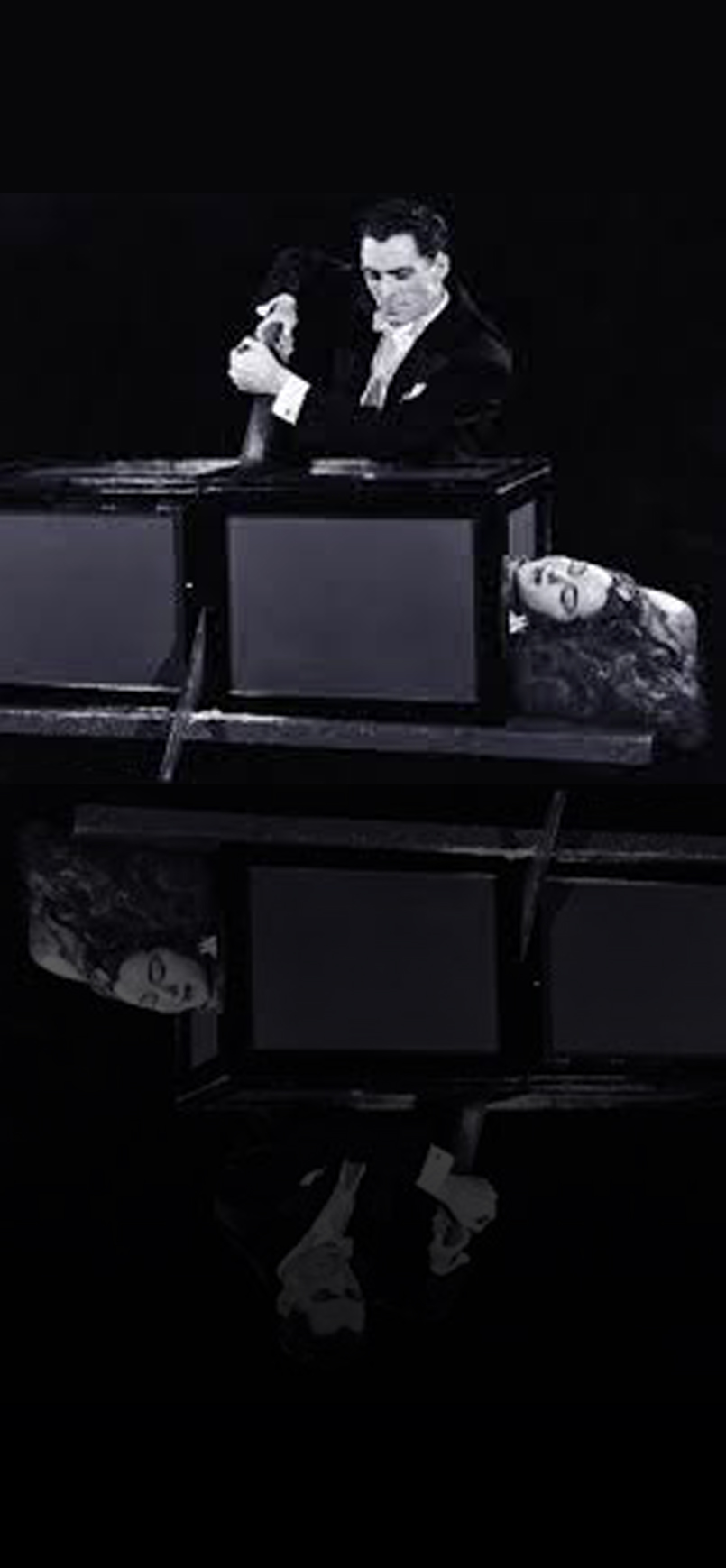 👆 A woman in a black box being cut in half
👆 A woman in a black box being cut in half
